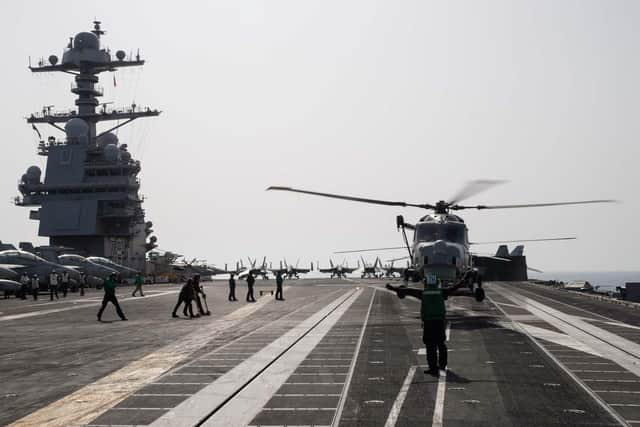Royal Navy: Wildcat helicopter deployed on HMS Duncan becomes first British aircraft to land on USS Gerald R Ford
and live on Freeview channel 276
The Wildcat helicopter, deployed with HMS Duncan in the Mediterranean, was used in exercises on the US Navy’s USS Gerald R Ford aircraft carrier. HMS Duncan is currently leading the Standing NATO Maritime Group 2 (SNMG2) task force in the region.
The force of warships patrols the central and eastern Mediterranean to protect its waterways and provide a powerful security presence. The Type 45 destroyer took up the leadership role after undergoing a major refit, and is planned to be deployed over the next six weeks.
Advertisement
Hide AdAdvertisement
Hide Ad

SNMG2 will operate alongside the USS Gerald R Ford’s task group in the coming weeks. The Wildcat was dispatched to the aircraft carrier for a planning conference ahead of upcoming joint operations.
Royal Navy Commodore Paul Stroude, who commands SNMG2, was transported by the helicopter from HMS Duncan to the 100,000-tonne American aircraft carrier with his staff. The helicopter became the first British aircraft to land on USS Gerald R Ford’s vast flight deck.
Wildcat Flight Commander, Lieutenant Sean Bending, said: “As a pilot it is a real privilege to land on an ally’s ship for the first time. The ability to fly our aircraft between the different classes and nationalities of ships is key to allowing us to operate effectively together.
SEE ALSO: HMS Duncan back on deployment


“The Ford class aircraft carriers will be in service for at least 50 years so it was extremely important to demonstrate that we can use their deck. Flying from the deck of a destroyer to a carrier, there is a huge difference in both size and the number of aircraft and people around.
Advertisement
Hide AdAdvertisement
Hide Ad"It is a truly impressive sight to see that much aviation activity being conducted in one place.”
Commodore Paul Stroude RN, added: “SNMG2 will be operating in close co-operation with the ships of Carrier Strike Group 12 for several months in the Mediterranean.
“This was a vital opportunity to cement our working relationship and to plan the next period of activity.” USS Gerald R Ford visited Portsmouth last November.